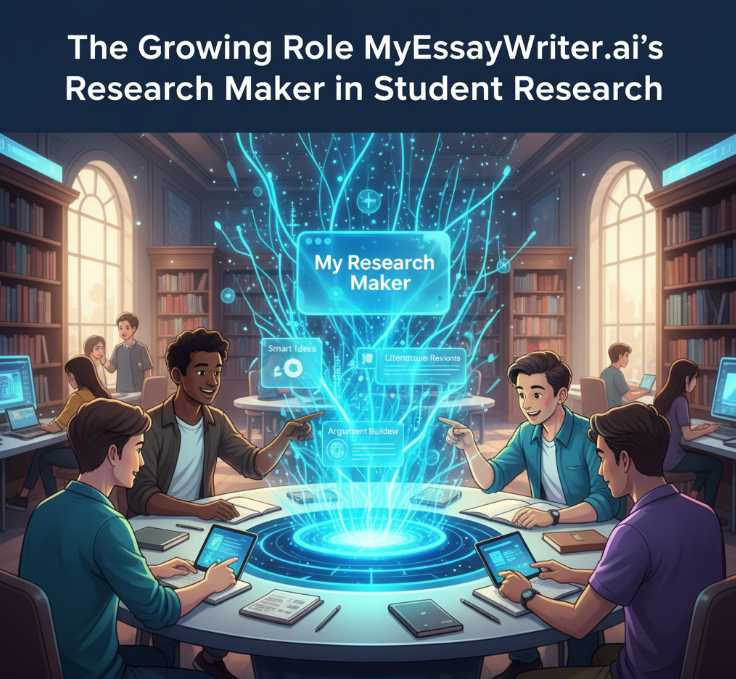In recent semesters, a subtle but meaningful shift has taken place in student research workflows: MyEssayWriter.ai’s Research Maker is becoming a go-to starting point for many. Rather than launching into literature searches or drafts in a vacuum, students now often begin with structured ideation generated by AI. This change is more than just a convenience; it reflects how best AI essay writer platforms are influencing academic norms, process flow, and the nature of creativity in research. In this post, we’ll explore why Research Maker is gaining ground, how it fits into the broader writing stack, what users appreciate (and critique), and what its rise suggests about the future of student-driven scholarship.
Why Research Maker Is Becoming Central
One of the biggest obstacles in student research is narrowing a broad interest into a manageable, clearly focused topic. Research Maker offers a remedy: by letting users supply keywords, themes, or domain hints, it generates possible research directions, framing questions, or mini-outlines. That scaffolding helps prevent the “blank page paralysis” many students face.
The appeal is compounded when time is limited. Rather than spending hours reading abstracts or scouring databases to zero in on a topic, students can use Research Maker as a rapid ideation boost. From there, they refine, filter, and select a direction that fits constraints or resources.
Peer adoption plays a major role. As more students mention “I used Research Maker first” in study groups or online forums, the tool gains legitimacy. Because it’s embedded in a platform already used for drafting, editing, and humanizing, it becomes part of the flow rather than a side experiment.
As the guest post about essay writer tools notes, once users see consistent value, trust builds and what was once a supplemental feature becomes a standard expectation. In this light, Research Maker’s growth is both technical and cultural.
Integration & Workflow Synergy
Research Maker’s utility magnifies when it’s integrated with other tools in the writing pipeline. Modern AI writing suites often include modules like outlining, drafting, paraphrasing, grammar correction, citation, humanization, and detection. Research Maker sits at the ideation juncture.
When a student picks a direction from Research Maker, that context flows directly into outline creation and drafting. No re-entering of topics or keywords is needed. This continuity keeps momentum strong. Users don’t lose context jumping between tools, which often causes wasted effort or misalignment.
Even if students still consult external resources like Google Scholar, ChatGPT, or domain databases, having a built-in Research Maker reduces tool-hopping. The smoother the chain from idea → outline → draft, the more likely a student continues in one productive session.
This chaining of generation tasks parallels developments in Natural Language Generation, where systems preserve context across modules to minimize prompt resets (see Natural Language Generation). In that sense, Research Maker is not just a standalone feature but an essential link in a coherent writing engine.
Student Perspectives: Gains, Warnings & Best Approach
Gains
Many students say Research Maker accelerates their start. Instead of feeling stuck, they often walk away with several possible research angles and can immediately begin refining. That jumpstart reduces procrastination and builds confidence. Some even credit it with revealing niches or variables they wouldn’t otherwise have considered.For proposal or early-submission phases, a polished candidate title and direction can signal clarity to supervisors, increasing the likelihood of quick approval.
Warnings & Critiques
However, reliance on machine-generated suggestions can backfire if students accept titles uncritically. Some generated ideas are too generic or mismatched with methodology and resources. Faculty may flag titles that sound formulaic or AI-tinged unless students heavily tailor them.Also, if students treat suggestions as fully formed, they may skip deeper thinking or domain reading. The tool is a guide, not a substitute for scholarship.
To mitigate risks, best practice involves customizing suggestions: infuse domain-specific terms, vet against literature, and align with research design. Use the suggestions as scaffolds not endpoints.
Students referencing the guest post on essay writer tools often emphasize this balanced approach: trust but verify, and always build on AI output with personal insight.
What This Trend Signals for the Future of Research Writing
The rising adoption of Research Maker suggests a future where ideation gets increasingly automated and interactive. We may soon see discipline-specific models titles and directions fine-tuned for fields like biology, economics, or philosophy.
Furthermore, tools may evolve to bundle ideation with outline and even preliminary source suggestions turning the early stage into a single interactive session. Peer feedback or instructor ratings on AI-generated ideas may become part of the workflow, enabling hybrid human-AI curation.
As students and faculty grow more accustomed to AI support, norms may change: using a research ideation tool might be expected rather than questioned. Evaluation might shift to how well students refine AI suggestions rather than whether they used AI at all.
If adopted thoughtfully, Research Maker can help students focus on insight and argumentation more than phrasing and scaffolding. But misuse could foster superficiality. The future of research writing may depend less on raw human drafting and more on how we guide, critique, and build upon AI-generated foundations.
Conclusion
The growing role of MyEssayWriter.ai’s Research Maker in student research reflects more than a feature trend; it represents a shift in how we begin scholarly inquiry. Its convenience, integration, and peer-driven legitimacy are reshaping early-stage writing habits. But its value depends on how well students use it: as a launchpad, not a crutch. In the months ahead, the boundary between human insight and machine assistance will continue to blur and students who master that balance may lead the new frontier of academic writing.
Other helpful articles
How MyEssayWriter.ai’s Research Title Generator Became a Student Favorite?
Myessaywriter.ai’s Research Maker Becomes Popular with Students in September 2025
Students Embraces Myessaywriter.ai’s AI Content Detector for Smarter Writing

















